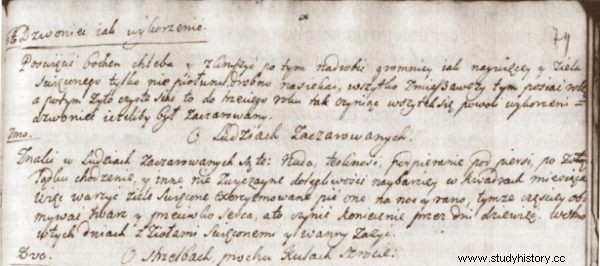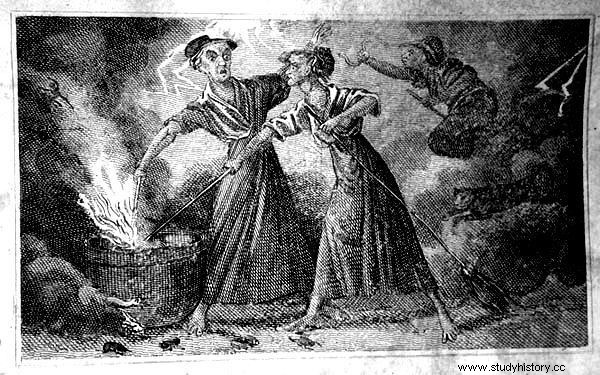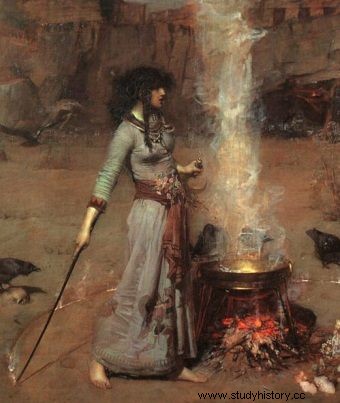A country without stacks? Not necessarily. Witches were hunted not only in Germany, France and England, but also further east - for example in Lithuania. Of course, the "fashion" for this kind of persecution and trials came from the West, but in the East it took a specific, local form.
Witch hunts began much later in Lithuania than in other countries. The first mention is made of the trial from 1563. The basic reason is obvious - Lithuania was Christianized as the last country in Europe and in the 15th or 16th century using magic or herbalism was the norm rather than a deviation there.
As Gintaras Beresnevičius and Tomas Čaplinskas wrote, if the Grand Duchy wanted to apply the same principles as in the West,
ninety percent of the population would be considered sorcerers and witches. Therefore, people were limited to judging those accused of witchcraft, and relics of pagan customs and rituals in which entire villages continued to participate were looked at through the fingers.
Moreover, in the 16th century, the Reformation took root in the Grand Duchy of Lithuania, which was less panicky about witchcraft and satanic conspiracies.
On a larger scale, witch trials came to Lithuania only with the Catholic Counter-Reformation. In defense of faith, they tried to follow the same patterns as in the West, e.g. looking for clandestine groups of up to several dozen people, including public figures.
The guilt was proved, for example, by detecting the "devil's seal" on the bodies of the accused . This method is well known from Germany or France.
So what was the difference between Lithuanian witches and the hunts for them and those led west of the Elbe?
Prophetesses, herbalists… and protectors of fire to bring the plague
First, the Grand Duchy has never managed to confine magic to uniform, "imported" stereotypes.
The object of persecution was different from, for example, in Germany. Not so much "ordinary" witches were hunted, but primarily herbalists and herbalists who used magic.
Moreover, in Lithuanian folklore has survived the vision of witches as figures associated with the divine, not necessarily villains .
Their primary skill was not to cast spells, but to foretell the future. Lithuanian word ragana meaning witch is probably derived from "see", "anticipate".

Excerpt from the page from "About the enchanted people" - a code belonging to the Discalced Carmelite convent in Vilnius (18th century).
Many trial testimonies prove the authenticity of Lithuanian magic - more often than in the West, there are descriptions of rituals that were probably actually carried out and not made up according to the pattern taken from the Torture Handbook. An excellent example is the testimony from the trial of Z. Szlekinowa, who was tried in 1680 at the Rawel manor in the Widukle district. The Lithuanian authors mentioned above quote them as follows:
The accused and other witches, wishing to harm Mr. Blinstrub, resorted to the aid of the devil Paul; the one in the pigsty strangles the piglet and sucks its blood, the accused hides the piglet under the ice during Christmas Eve, and sprinkles its blood on the courtyard so that you and their children will die after two years.
The ritual, the authors conclude, is quite convincing and rather not made up on a torture bench. The date of the events (Christmas Eve - the day when all spells are particularly effective) and the method of murder used by the devil (suffocation) fit into Lithuanian superstitions.
Lithuanian witches also have many other unusual features. For example, they rarely fly on brooms - it seems that they were more comfortable straddling ... flying hives . Where did they fly to?
They had more fantasies in this respect than their Polish or European friends. They were going to the land from the afterlife, to a mountain overgrown with peas. Their powers also seem unusual and often more sinister than in other countries.
Forget about innocently enchanting cows so that they don't produce milk. Ragana, it is believed that she could do much more:even bring the plague on someone!
However, it was not disease that was her main domain. According to another Lithuanian researcher, Norbertas Velius, Lithuanian witches were inseparable from fire - they were even called keepers of fire.
The honest benefit of secular process
Lithuanian magical beliefs were extensive and common. There is no doubt that there were many more (perhaps even several dozen times more) "real" witches in the Grand Duchy than in the West. And yet their processes are quite unique.
While as many as 100,000 witch trials were carried out throughout Europe, and around 20,000 in Germany alone, in Lithuania ... 363 people were tried for witchcraft.

Lithuania is a paradise for witches?
In addition, of them - over two centuries - only 75, or 1/5, were lost. As stated by Beresnevičius and Čaplinskas:
it was easy to become a witch, but much more difficult to deal with in an official court.
In addition, the trials took place only in Samogitia. Neither in eastern Lithuania nor in the Belarusian lands was this subject of the mind.
The real uniqueness of Lithuanian witch hunts is that people of the Church were not admitted to them until the 18th century. Maybe the Counter-Reformation was an impetus for persecution and a role model, but trials have always been held in civil courts.

In Lithuania, people of the Church were not allowed to hunt witches until the 18th century.
They were attended by lay witnesses, gentlemen from the court, the family of the accused, etc. It was unusual, however, to invite clergymen.
This changed only in 1703 - then King August II, at the instigation of Stanisław Szembek, the bishop of Kuyavia, transferred the right to conduct witchcraft trials from civil to church courts. By this time, the very institution of witch hunts in Europe was already a thing of the past.
It was the last to come to Lithuania and it was probably the last to eradicate it. The last trial - over the peasants from the Dominican monastery in Rosenia - took place in 1771. Five years later, the Warsaw Sejm finally banned trial suspects of witchcraft in the Polish-Lithuanian state.
Finally, a curiosity. In 1551, Zygmunt August ordered Mikołaj Radziwiłł the Black to lock up Bona Sforza's maid, accused of casting a charm that contributed to the death of Barbara Radziwiłłówna in the castle in Dubinki. This was an obvious exception, because until the beginning of the 18th century the secular authorities were not interested in actively prosecuting witches.
Sources:
Basic:
- Gintaras Beresnevičius and Tomas Čaplinskas, The Witch [in:] The culture of the Grand Duchy of Lithuania. Analyzes and images , Universitas, Kraków 2006, pp. 143-161.
Complementary:
- B. Baranowski, Witch trials in Poland in the 17th and 18th centuries , Łódź 1952.
- B. Levack, The Witch-Hunt in Early Modern Europe , Longman 1995.
- K. Sochaniewicz, A contribution to the spells on Samogitia in the 17th century , Lviv 1922.
- J. Tazbir, Witchcraft trials , "Rebirth and Reformation in Poland", vol. 23, 1978.
